We had a direct flight from Pittsburgh to London so the fact that it was a couple hours late did not matter. It was after noon London time before we checked into our hotel. At that point we had been up over 24 hours so we did not feel like touring.
We have been to London before so not touring was not that big a deal. What to do when you are tired and worn out from being awake so long? You find a pub! Georgie was sure happy with that idea.
Sunday morning we were bussed to Southampton to board the Norwegian Dawn, our home for the next eleven days.
Most of the Washington crew gathered on the pool deck for the departure. Here are Jim, Gary, Wendy, Anne Marie, Patrice, John, Georgie, Gail and Nanc celebrating the bon voyage. Sunday and Monday were days at sea sailing north to Scotland.
Our first port was South Queensferry where we had to take a tender to shore for our excursion. The tender took us under the Firth Bridge. The bridge opened in 1890 after eight years of construction. When it opened to rail traffic it was the longest cantilever bridge in the world and is still the second longest.
A true Scottish welcome with bagpipe, drum and kilts.
Our tour in Edinburgh, the Scottish capital, was Walk in the Royal Mile. It began at the Edinburgh Castle in the Old City and ended at Holyrood Palace.
The Scotch Whisky Experience offers tours and tastings. We passed.
The Writer's Museum commemorates the lives of Robert Burns, Sir Walter Scott and Robert Louis Stevenson, the three giants of Scottish literature.
The Mercat Cross marks the old market square of the city.
Yes they still have these in the United Kingdom. I believe they are only used as sign boards and maybe private cell phone calls these days.
No. 1 High Street is an old time Scottish Pub. Unfortunately, it was to early and they were not open. I really took this picture of the sports cars stopped at the light. They were part of a tour by car group, something to add to our to do list on the next visit.
There are many little alleys and walkways off the Royal Mile that are very interesting.
It does not get any fresher than this. Once again, they were preparing for lunch and were not open.
At the end on the Royal Mile is Holyrood Palace. It has been the official residence of the royals when they are in Scotland since the 16th century. A nice little vacation home when they are away from their palaces in England.
This building was referred to as the bath house of Mary Queen of Scots (1542-1567). At that time it was part of the wall that surrounded the king's privy garden.
The new (1999) Parliament Building sure is a contrast to the much older buildings in the city. We all agreed that this tour was very rushed with little time to explore. During the tour our guide just kept walking and talking so the group got very spread out.
On day 4 we awoke in Invergordon, a town with a deep harbor that serves both big cruise ships and, as you can see, the North Sea oil industry. Our excursion this day was Loch Ness, Urquhart Castle & Inverness Overview.
After a 28 mile bus ride we arrived at Urquhart Castle overlooking Loch Ness. The castle, now in ruins, dates back to the 13th century. It played a role in the Wars of Scottish Independence and was once the royal castle. This is a model of the castle at its largest.
The trubuchet was a type of catapult used to knock down the walls of castles that were under siege. There is no record of them being used here, but there were many large round stones there that could have been thrown at the castle.
The watchtower and the gate house are the most intact part of the castle remaining.
Georgie, Jim and Nanc at the castle door. That is Loch Ness in the background.
Yes, we did see Nessie!
A modern mansion overlooking Loch Ness. Built by a very wealthy entrepreneur from the area.
We learned that Inverness overview means the bus drives through the city while the guide talks. This is Inverness Castle. There have been castles on this site since 1057. The present one dates to 1836 and is being renovated.
Inverness, the largest city in the Scottish Highlands, means Mouth of the Ness. The river flows from Loch Ness into Beauty Firth. We learned that a firth is a narrow inlet or estuary.
Farms along the Cromarty Firth. Taking in the countryside we were surprised at how green it was this time of the year.
We returned to Invergordon and walked into town to see some of the 14 murals. Unfortunately, it started to rain so we only saw a few. This one is Pipes and Drums.
This one, Gather Round, is dedicated to the Highland games.
While the overview of Inverness was not that great we really liked seeing Loch Ness, Urquhart Castle and the murals.
On day five we docked in Kirkwall in the Orkney Islands off the northern coast of Scotland. Our excursion was Ancient Treasures of Orkney and ancient they were, dating back 5,000 years. Our first stop was the Standing Stones of Stenness. You can see how tall they were.
Only four of the original stones are still standing. There would have been a ditch surrounding them at one time. They were also in a sheep field requiring care in where you stepped.
Nearby is the Ring of Brodgar, a near perfect circle of stones. Only 27 of the original 60 remain standing. Unlike Stonehenge, there are no stones inside the circle. Since the Ring of Bordgar is so ancient, when it was built has remained unknown.
Riding through the Scottish countryside there are many of these old stone buildings. These Scots have to be hardy people to survive on the far north islands.
Our last ancient stop was Skara Brae, a stone built Neolithic settlement. The site dates back to between 3180 BC to about 2500 BC. This is a replica of what the houses would have looked like.
The interiors had stone furniture and hearths. There was a sewer system that carried waste in to the ocean. This is the oldest known village in Europe where you can see original stone furniture.
In recent times the site was buried until a storm in 1850 eroded the beach uncovering the remains of the village. The site was first examined by a local geologist, William Watt, but was left undisturbed until 1913. That year it was plundered and many artifacts were carried away.
A 1924 storm washed away part of a house and after that the University of Edinburgh started a major excavation and preservation. This is a house without the roof.
The Skaill House was built in the 17th century. It is one of the best preserved mansions of that era in Scotland. It is on the land where Skara Brae was unearthed.
The house is surrounded by farm land.
The greenness of the fields of Scotland this far north is amazing. We enjoyed this excursion and would recommend it.
Leaving Kirkwall we passed this lighthouse and old light keepers house.
The group for Washington often gathered in the "purple chair lounge" to listen to music and have a toddy before dinner. Here are Nanc, Georgie, Gail, Becky, Suzanne, Wendy, Anne Marie, Patty, Ron, Gary and Jim.









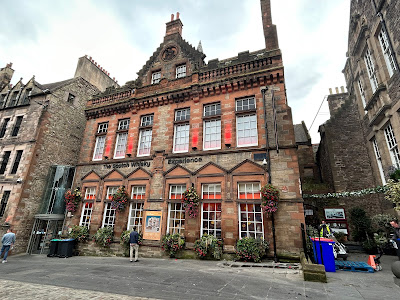




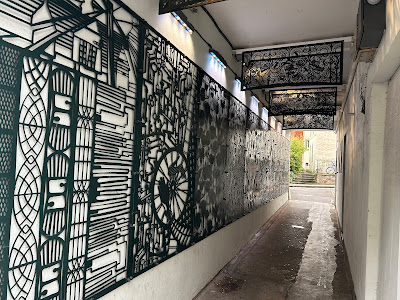

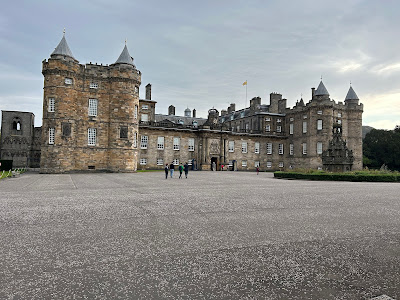
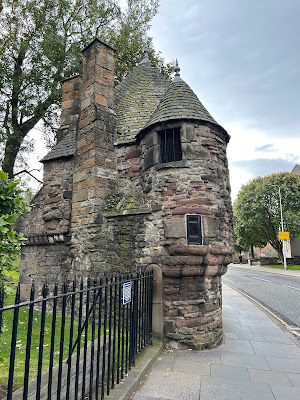


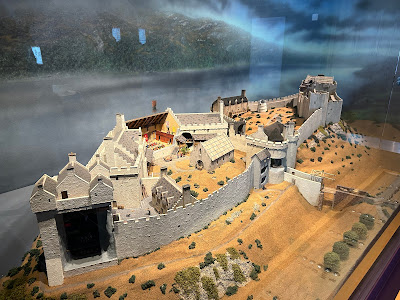










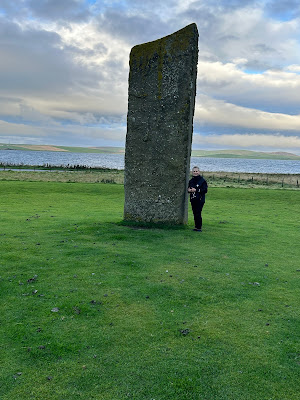










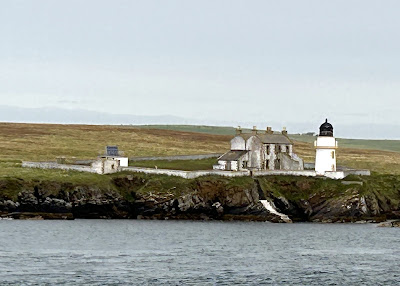

1 comment:
Nice post. We prefer self guided tours.
Post a Comment